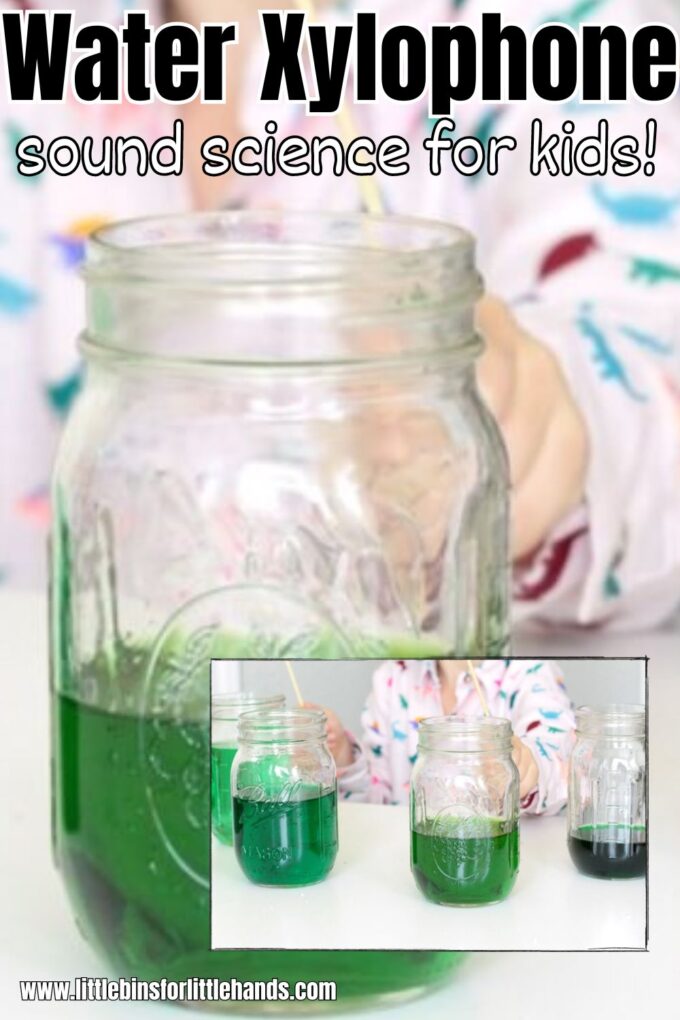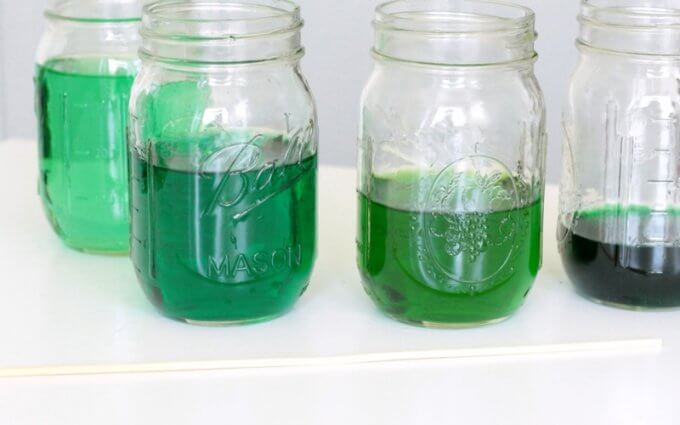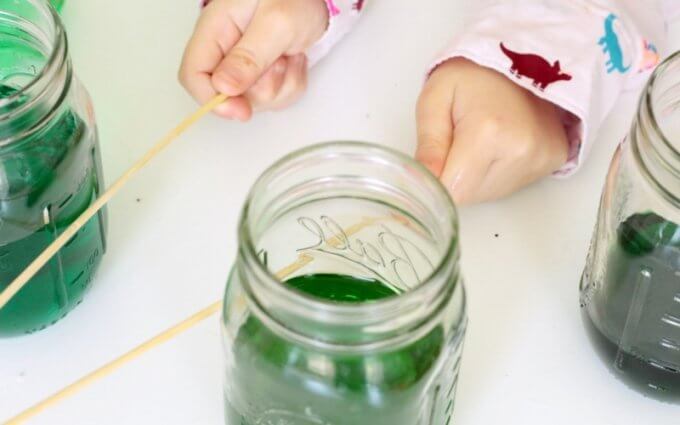Science truly surrounds us even in the sounds we hear! This water xylophone experiment is truly a must do science activity for young kids. So simple to set up, it’s kitchen science at it’s finest with plenty of room to explore and be playful with it. Try this easy sound waves experiment with water in glass jars for a hands-on science project for kids.

Explore Sounds Waves With Water
Have you ever heard of the phrase kitchen science? Ever wondered what it means? It’s probably pretty easy to guess, but I will share anyway! Let’s show our kids how cool it is to play with science.
Read more below on how you can extend this sound science experiment, add in the scientific process, and create your own sound waves science experiment.
Kitchen science is science that can come out of the kitchen supplies you have! Easy to do, easy to set up, inexpensive, and perfect science for young kids. Set it up on your counter and go!
For several pretty obvious reasons, a homemade water xylophone experiment is the perfect kitchen science! All you need is mason jars {or other glasses}, food coloring, water, and set up chopsticks or even a spoon or butter knife to explore sound.
ALSO CHECK OUT: 30 Water Experiments For Kids
Did you ever wonder how to make science easy enough to do at home or with a larger group of kids, this is it! We love sharing the simplest of ideas to get you started and comfortable with sharing science with your kids.

What Is The Scientific Method For Kids?
The scientific method is a process or method of research. A problem is identified, information about the problem is gathered, a hypothesis or question is formulated from the information, and the hypothesis is tested with an experiment to prove or disprove its validity.
Sounds heavy… What in the world does that mean?!? It means you don’t need to try and solve the world’s biggest science questions! The scientific method is all about studying and learning things right around you.
As children develop practices that involve creating, gathering data evaluating, analyzing, and communicating, they can apply these critical thinking skills to any situation.
READ MORE HERE: Using The Scientific Method with Kids
Note: The use of the best Science and Engineering Practices is also relevant to the topic of using the scientific method. Read more here and see if it fits your science planning needs.
Helpful Science Resources To Get You Started
Here are a few resources that will help you introduce science more effectively to your kiddos or students and feel confident yourself when presenting materials. You’ll find helpful free printables throughout.
- Best Science Practices (as it relates to the scientific method)
- Science Vocabulary
- 8 Science Books for Kids
- All About Scientists
- Science Supplies List
- Science Tools for Kids
- Join us in the Club
Get your free printable science guide!
How Does A Water Xylophone Work
When you tap the empty jars or glasses, they all made the same sound. Adding different amounts of water changes the noise, sound, or pitch.
What do you notice about the amounts of water versus the sound or pitch that is created? The more water, the lower the pitch! The less water, the higher the pitch!
Sound waves are vibrations that travel through the medium which in this case is water! When you change the amount of water in the jars or glasses, you also change the sound waves!
Water Xylophone Experiment
Make sure to have your kids tap the empty jars first to get an idea of the starting sound! Have them predict what will happen when they add water. They can also create a hypothesis to explain what happens when more or less water is added. Read more here on the scientific process for young kids.
Supplies:
- Water
- Food coloring (we used blue, yellow and green for varying shades of green)
- Wooden sticks (we used bamboo skewers)
- 4+ mason jars

Instructions:
STEP 1. Fill the jars with varying levels of water. You can eyeball the amounts or grab the measuring cups and get a little more scientific with your exploration.
STEP 2. Add food coloring to make different colors for each note. More water equals lower sound or pitch and less water equals a higher sound or pitch. We made our jars pure green, dark green, blue-green, and yellow-green!

Things To Try With Your Water Glass Xylophone
- Does tapping the sides of the jars make a purer sound than tapping the tops of the jars?
- Try adjusting the water levels to create new sounds.
- Try using different liquids and compare results. Different liquids have different densities and the sound waves will travel differently through them. Fill two jars the same amount but with two different liquids and observe the differences!
- Try using different tools for tapping the glasses. Can you tell the difference between the wood chopstick and a metal butter knife?
- If you want to get super fancy, you can use a tuning app to raise or lower the water level to match specific notes. We tested out this one a little bit although we are not music experts over here, it’s a fun way to take the experiment a step farther for older kids.

More Fun Ways To Explore Water Science
- What dissolves in water?
- Can water walk?
- How do leaves drink water?
- Great skittles and water experiment: Why don’t the colors mix?
- What materials absorb water
- How does water refract light?

Printable Science Projects For Kids
If you’re looking to grab all of our printable science projects in one convenient place plus exclusive worksheets and bonuses like a STEAM Project pack, our Science Project Pack is what you need! Over 300+ Pages!
- 90+ classic science activities with journal pages, supply lists, set up and process, and science information. NEW! Activity-specific observation pages!
- Best science practices posters and our original science method process folders for extra alternatives!
- Be a Collector activities pack introduces kids to the world of making collections through the eyes of a scientist. What will they collect first?
- Know the Words Science vocabulary pack includes flashcards, crosswords, and word searches that illuminate keywords in the experiments!
- My science journal writing prompts explore what it means to be a scientist!!
- Bonus STEAM Project Pack: Art meets science with doable projects!
- Bonus Quick Grab Packs for Biology, Earth Science, Chemistry, and Physics










Super